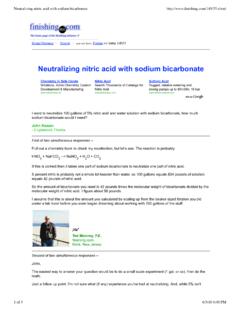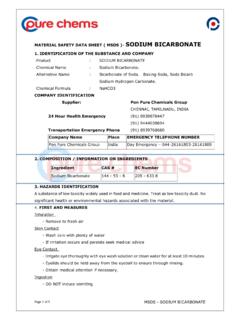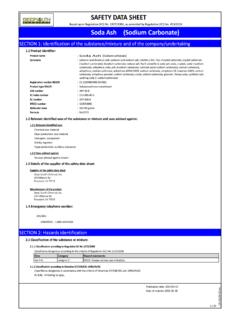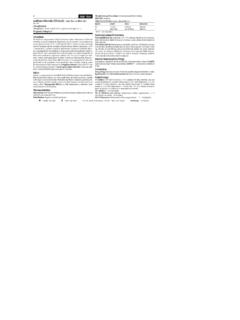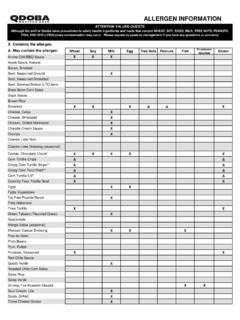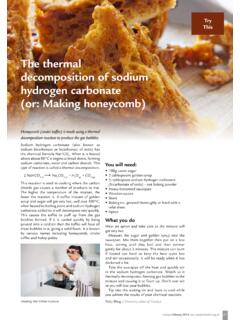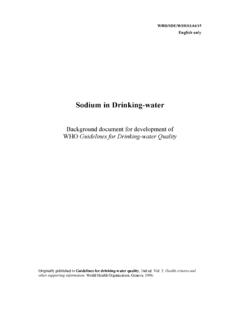Transcription of Normal Vital Signs - MU School of Health Professions
1 Normal Vital Signs Blood Pressure: Adults: defined with 2 measurements on 2 different dates at least 2 weeks apart Normal BP <120/<80 mmHg PreHTN: 120-139/80-89 mmHg HTN Stage I: 140-159/90-99 mmHg HTN Stage II: >160/>100 mmHg Children: Birth (12 Hr, <1000g): 39-59/16-36 mmHg Birth (12 hr, 3 kg): 50-70/25-45 mmHg Neonate (96hr): 60-90/20-60 mmHg Infant (6 mo): 87-105/53-66 mmHg Toddler (2 yr): 95-105/53-66 mmHg School Age (7yr): 97-112/57-71 mmHg Adolescent (15yr): 112-128/66-80 mmHg Heart Rate: Adults: Female: 55-95 bpm Male: 50-90 bpm Children: Neonate: 100-180 bpm awake 80-160 bpm asleep Infant (6mo): 100-160 bpm awake 75-160 bpm asleep Toddler: 80-110 bpm awake 60-90 bpm asleep Preschooler: 70-110 bpm awake 60-90 bpm asleep School -aged child: 65-110 bpm awake 60-90 bpm asleep Adolescent: 60-90 bpm awake 50-90 bpm asleep Respiration Rate: Adults: 12-18 breaths per minute Children: Infants: 30-60 breaths per minute Toddlers: 24-40.
2 Preschoolers: 22-34. School -aged children: 18-30. Adolescents: 12-16. Page 1 of 6. Emergency Procedures 1. Stroke & TIA. Signs /Symptoms: Sudden numbness or weakness of the face, arm or leg, especially on one side of the body Sudden confusion, trouble speaking or understanding Sudden trouble seeing in one or both eyes Sudden trouble walking, dizziness, loss of balance or coordination Sudden severe headache with no known cause Response: Immediately call 911 or the emergency medical services (EMS) team so an ambulance (ideally with advanced life support) can be sent. Check the time so you'll know when the first symptoms appeared. Immediate action can decrease the risk of loss of function/disability and sensation. Medical tx within 3-6 hrs can help prevent the most severe consequences of stroke. Evaluation within 60 minutes is ideal.
3 Not all warning Signs occur in every stroke. Don't ignore Signs of stroke, even if they go away. Monitor Vital Signs : blood pressure (B), HR, RR, and keep the patient calm and comfortable until help arrives. **Symptoms of TIA begin suddenly and are similar to those of stroke, but leave no residual damage. By definition, symptoms of TIA resolve within 24 hours, but typically they last less than five minutes, about one minute on average. Because the symptoms of TIA cannot be distinguished from those of acute stroke, these symptoms must be aggressively treated as soon as possible. 2. Hypoxemia (Decreased O2). Signs /Symptoms: Shortness of breath &/or dyspnea Cyanosis Tachycardia Tachypnea Fatigue Mental Status Changes: confusion, agitation, memory loss, depression Poor nighttime sleep &/or morning headaches Response: Stop activity & have patient sit & rest Provide supplemental oxygen (if prescribed).
4 Instruct patient in deep breathing techniques Record PulseOx sats Check & record other Vital Signs (including lung auscultation). Page 2 of 6. 3. Decreased BP/Hypotension (Systolic pressure below 100 mmHg). Causes: blood volume cardiac output Valsalva maneuver blood flow to heart (Vm). Orthostatic hypotension following rapid position changes Pregnancy (usually not acute). Medications Heart problem (bradycardia, ischemia, heart failure, valve malfunction). Dehydration Endocrine problems (thyroid dysfunction, diabetes). Severe infection (septic shock). Allergic reaction Postprandial hypotension (after meal in older adults). Nutritional deficiencies (B-12 and folic acid). Neurally mediated (long time standing). Shock Stress/trauma Signs /Symptoms: Dizziness or light-headedness Loss of consciousness/syncope Diaphroesis (excessive perspiration).
5 Nausea Blurred vision Lack of concentration Fatigue Depression Thirst Rapid/shallow breathing Response: salt intake Hydrate (drink water). Elevate the legs perform ankle pumps (contraindicated in CHF as it would cause orthopnea). Lie down, to get blood back to heart (contraindicated in CHF as it would cause orthopnea). Contract leg muscles to pump blood back to heart After symptoms subside, the patient may return to sitting if there is a gradual progression to the upright position. Page 3 of 6. 4. Increased BP/Hypertension Signs /Symptoms: Usually none, but for dangerously high levels, check for headache, blurred vision, confusion, ear noise or buzzing Response: 1. Always check vitals before doing activity. Terminate exercise: If SBP is > 220 mmHG and/or if DBP > 110 mmHG exercise is to be terminated. 2. If patient is having no additional symptoms such as angina, diaphoresis, pallor, nausea, confusion, ataxia, or dizziness continue to monitor BP every 5 minutes until SBP returns to within 10-20 mmHG.
6 Of pre-exercise and notify the PCP. Do not re-initiate exercise unless approved by the physician. **If these symptoms are present the following should be done: Call 911 if angina is not relieved with Nitro or the above symptoms are persistent and BP does not decrease. -- Or -- If the patient has significant report of symptoms that is relieved with rest, monitor vitals every 5. minutes until BP reaches 10-20 mmHG of pre-exercise values and call PCP. 5. Hyperglycemia & Hypoglycemia a) Hyperglycemia Treatment: Insulin should be given in a hospital (Children U/kg & Adults 10% - 20% of total daily dose.). b) Hypoglycemia Treatment: When a patient has severe hypoglycemia and becomes unconscious it should be treated with an emergency glucagon kit (which require a prescription). After injecting glucagon, follow with food once the person regains consciousness and is able to swallow.
7 Causes Onset Blood Sugar Symptoms What Can You Do? Hyperglycemia/ Too much Gradual, Above 200 Extreme thirst, Test blood sugar, if ketoacidosis food, too may mg/dL frequent urination, over 200mg/dL for little insulin, progress to Acceptable dry skin, hunger, several tests CALL. illness or diabetic range: 115- blurred vision, YOUR DOCTOR. stress coma 200 mg/dL drowsiness, nausea, confusion, difficulty breathing Hypoglycemia/ Too little Sudden, Below 70 Shaking, fast Drink a half a cup of insulin shock food, too may mg/dL, heartbeat, orange juice or milk much insulin progress to Normal sweating, anxious, OR eat several hard or diabetes insulin range: 70- dizziness, hunger, candies, test blood medicine, or shock 115 mg/dL impaired vision, sugar (if symptoms extra weakness, fatigue, don't stop, call your exercise headache, irritable, doctor), within 30.
8 Numb hands or feet minutes after symptoms go away eat a light snack (half a peanut better or meat sandwich and half a glass of milk). Page 4 of 6. Treating a conscious diabetic patient: If the patient is conscious and coherent, check their blood sugar level If the person is behaving oddly and is suffering from hypoglycemia but is still conscious and capable of swallowing then feed them sugar (fruit, orange juice, glucose, or white sugar dissolved in juice or water). If not dial 911 and keep trying. If the person is unable to swallow or you are unsure if they are capable of swallowing, then try rubbing some sugar or glucose gel on their gums If suffering from hyperglycemia, do not feed the patient. Push water while conscious and get the patient to medical treatment promptly. Treating an unconscious diabetic patient: If the person is unconscious dial 911 and put the patient in the recovery position.
9 Monitor Vital Signs . If the patient is unconscious and having seizures dial 911 and follow the first aid protocol for seizures (remove anything on which the patient could injure themselves and put in the recovery position once the seizure is over). ** NOTE: Since it is hard to tell if the person is suffering from hypoglycemia or hyperglycemia, you can give the person a small amount of sugar to see if it helps. If a small amount of sugar is given, then no harm will be caused to the person suffering from hyperglycemia!!!**. Exercising a Patient with Diabetes Check BS before, during, after o Before is < 100 snack o Before is 100 250 exercise without snack o Before: ideal is 120-160. Snack before, during, after, ie, every 30 minutes o snack if hypo = 20-30 (40g) carb 8oz OJ = 40g Continue to watch for hypoglycemia 4-6-12h post Inject a non-exercising part of the body (too prevent overly rapid action of the insulin).
10 Don't start exercise, OR stop if: o < 80 snack o > 250 (with ketones). o > 300 for Type I. o > 400 for Type II. Ideal BS before exercise = 120-160. Ideal BS during exercise = 90-140. **Autonomic neuropathy can mask perception of hypoglycemia Page 5 of 6. 6. Grand Mal (Generalized) Seizure Signs Loss of consciousness, falling down, loss of bowel or bladder control, and rhythmic convulsions. Muscle contractions and rigidity Falls, Rapid pulse, Pallor, Dilated pupils Biting the tongue, Frothing at the mouth Eyes rolling back in the head Immediate Recovery Gradual awakening to consciouness Confusion Long sleep (after a brief awakening). Full Recovery Fully awake, Normal mental stage (in some people). Tiredness, Depressed mood What to do: Protect the person from injury (remove harmful objects from nearby). Cushion their head Aid breathing by gently placing them in the recovery position one the seizure has finished.
